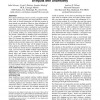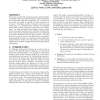23 search results - page 4 / 5 » Action recognition and understanding through motor primitive... |
AIIA
2005
Springer
13 years 11 months ago
2005
Springer
Abstract. In order to have a robotic system able to effectively learn by imitation, and not merely reproduce the movements of a human teacher, the system should have the capabiliti...
ICANN
2010
Springer
13 years 4 months ago
2010
Springer
Trajectory formation is one of the basic functions of the neuromotor controller. In particular, reaching, avoiding, controlling impacts (hitting), drawing, dancing and imitating ar...
UIST
2010
ACM
13 years 3 months ago
2010
ACM
New input technologies (such as touch), recognition based input (such as pen gestures) and next-generation interactions (such as inexact interaction) all hold the promise of more ...
INFSOF
2007
13 years 5 months ago
2007
This paper presents a framework that draws on Structuration theory and dialectical hermeneutics to explicate the dynamics of software process improvement (SPI) in a packaged softw...
ATAL
2006
Springer
13 years 9 months ago
2006
Springer
We present a method for learning a human understandable, executable model of an agent's behavior using observations of its interaction with the environment. By executable we ...


